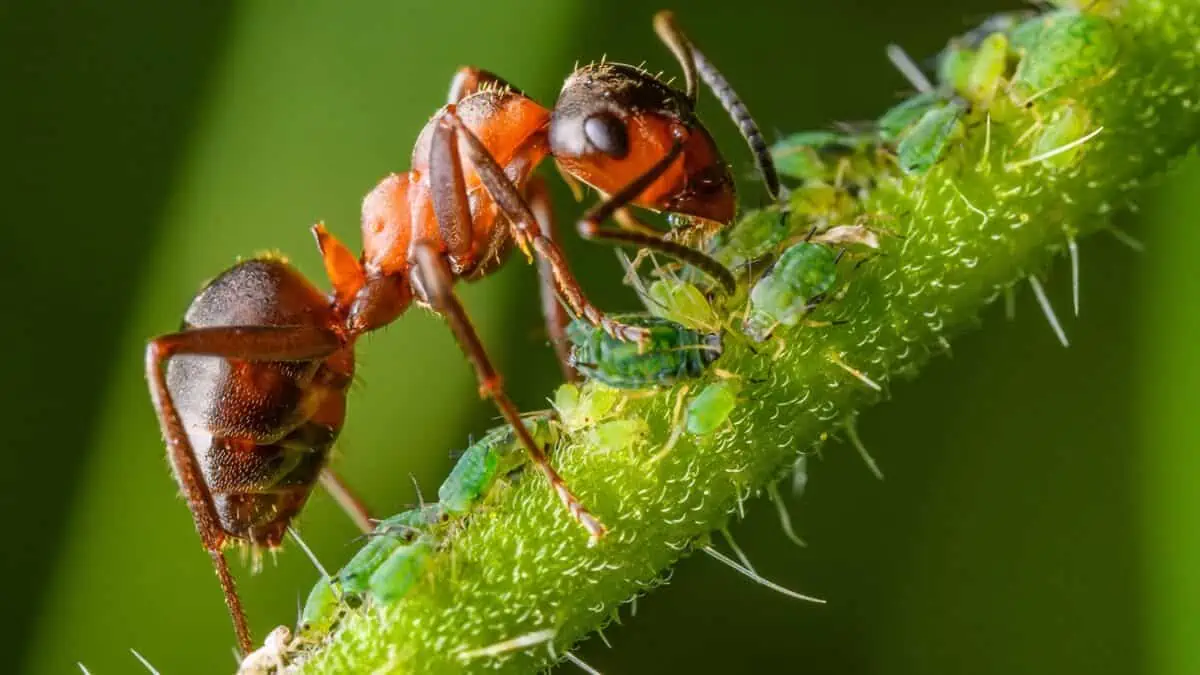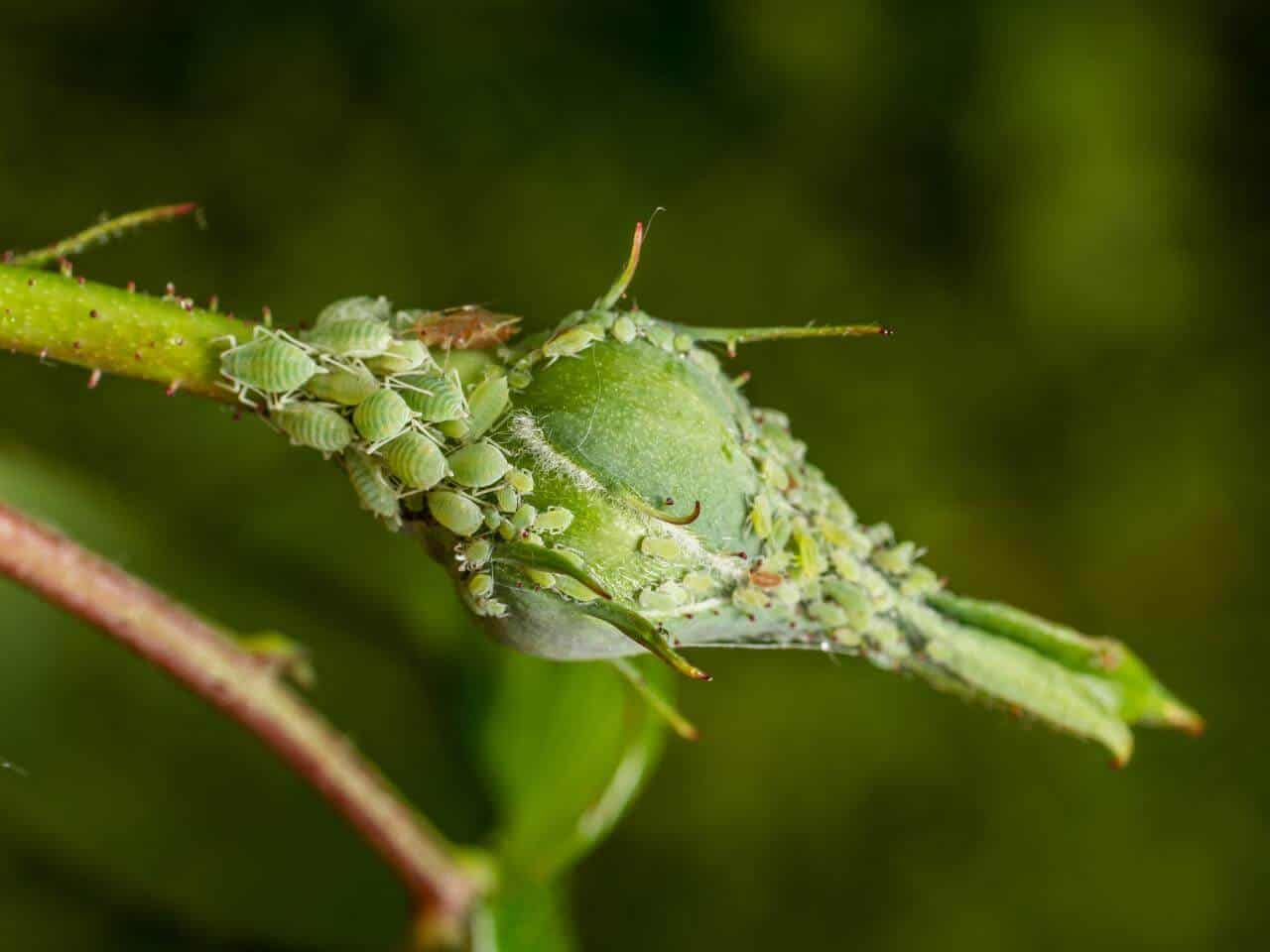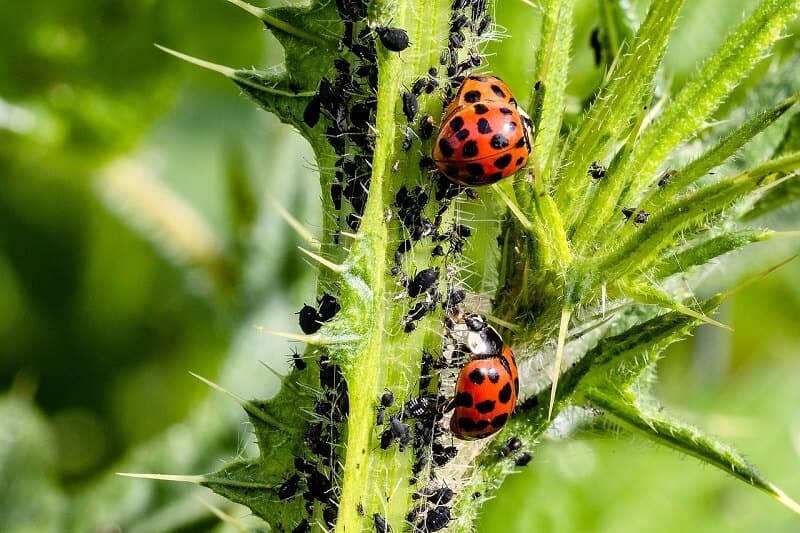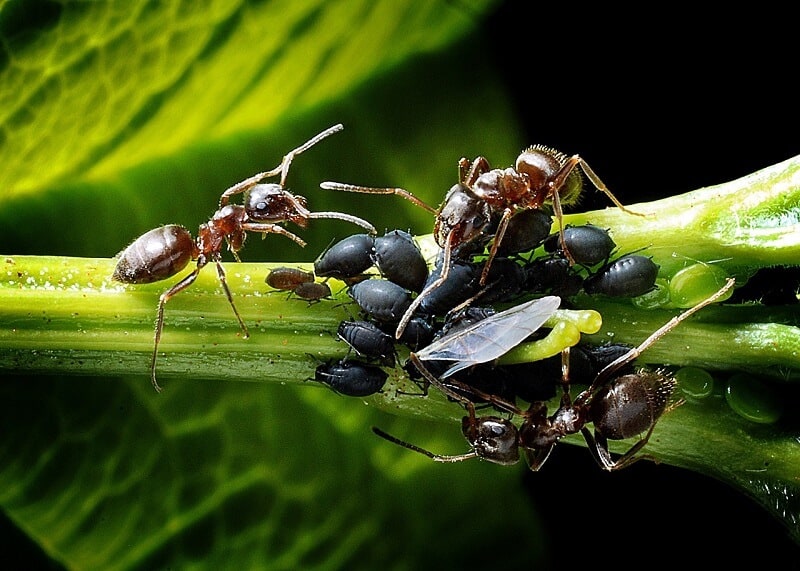Have you ever wondered how to get rid of aphids once and for all without treating your crop to harsh chemicals?
You are not alone.
That’s the same thing every environmentally conscious gardener wants. Because let’s face it, we can’t wish away pesky pests in our gardens now and then.
And we can’t just spray our gardens indiscriminately, especially with class 1 and 2 pesticides. Knowing exactly what to do when they strike can be a game-changer.
In this article, you’ll learn how to get rid of aphids naturally and efficiently. However, before we proceed, I must mention that most natural methods are only effective if you detect the infestation early.
Therefore, regular monitoring and relying on integrated pest management strategies will go a long way in safeguarding your plants.
Let’s dive in:
What Are Aphids?
Aphids are small, soft-bodied insects with long slender mouthparts that they use to pierce stems, leaves, and other tender plant parts and suck out fluids.
Almost every plant has one or more aphid species that occasionally feed on it. Many aphid species are difficult to tell apart. However, the control measures of most aphid species are similar.
You might also be interested in learning How to Get Rid of Flea Beetles on Eggplant Naturally.
How Can You Identify Them?
Aphids have soft, pear-shaped bodies with long legs and antennae, and they come in a variety of colors, from green, red, brown, yellow, or black, depending on the species and the plants they feed on.
A few species appear waxy or woolly due to the secretion of a waxy white or gray substance over their body surface. Most species have a pair of tubelike structures called cornicles projecting backward out of the hind end of their body.
The presence of cornicles distinguishes aphids from all other insects.
Generally, adult aphids are wingless, but most species also occur in winged forms, especially when populations are high or during spring and fall.
The ability to produce winged individuals allows the pest to disperse to other plants when the quality of the food source deteriorates.
Although they may be found singly, aphids often feed in dense groups on leaves or stems.
Unlike leafhoppers, plant bugs, and certain insects, most aphids don't scurry when disturbed.
What is the impact of their damage?
Leaf-feeding aphids are not necessarily damaging, especially when the numbers are low to moderate.
However, large aphid populations can turn leaves yellow and stunt shoots.
They can also produce large quantities of a sticky exudate known as honeydew, which often turns black with the growth of a sooty mold fungus, thus reducing a plant's ability to photosynthesize its food.
Some aphid species inject a toxin into plants, which causes leaves to curl and further distorts growth. A few species cause gall formations.
Aphids may transmit viruses from plant to plant on specific vegetables and ornamental plants.
The viruses mottle, yellow, or curl leaves and stunt plant growth.
Although losses can be significant, they are difficult to prevent by controlling aphids because infection occurs even when aphid numbers are very low.
It takes only a few minutes for the aphid to transmit the virus, while it takes much longer to kill the aphids, especially if you don’t have an effective strategy.
If your trees or garden matter to you, then getting rid of aphids permanently should become a priority as soon as you spot them.
Now that you know what aphids are, how to identify them, and what their impact on damage is, let’s get to several tactics for killing aphids.
How to Get Rid of Aphids Organically and Permanently
1. Always remember prevention is better than cure

Preventing ants indirectly prevents aphids.
The best strategy for dealing with plant pests and diseases is not to have to deal with them in the first place. The best way is always to prevent their infestation or infection.
Here is how to prevent aphids:
Keep the plant healthy by providing appropriate nutrition, water and pruning where necessary. Aphids and other bugs have a strong sense for weak, struggling plants.
Regular monitoring to identify and resolve any problems relating to nutrient deficiency early enough. Check your plants regularly for aphids—at least twice a week when plants are growing rapidly—to catch infestations early so you can knock or hose them off or prune them out.
Regulate the amount of Nitrogen-based fertilizer, especially during the vegetative growth stage.
In a recent study published in the PMC journal, it was established that limiting supplies of both water and N to trees was shown to reduce the severity of aphid infestation (green peach aphid, mealy plum aphid, and leaf curl aphid). However, reducing only the water supply was less effective.
2. Use push and pull strategy
The push and pull strategy is one of the most effective and natural ways to get rid of aphids permanently. It is the same method used in the control of corn stalk borers, where Napier grass is planted in companion with corn to attract and trap the stalk borer.
It is, therefore, essential to practice companion planting of crops in different families.
Precisely, plant members of the allium family, such as onion and garlic, in companion with your main crop. Plants in the Allium family are very effective in repelling and pushing away aphids.
On the other hand, plant crops in the brassica family, such as kale and collards, to attract and pull the aphids. If anything, aphids don’t cause much harm to these crops.
Alternatively, you can plant dahlia plant next to a susceptible crop. Dahlias are effective in attracting these bugs.
This strategy assumes that, given a choice, aphids will choose their favorite plant over any other.
If you want to learn more about this strategy, check out this document by the International Centre of Insect Physiology and Ecology (ICIPE).
3. Use yellow sticky traps
Most pests have phototaxis, and yellow is the favorite color of common pests like aphids. With this yellow sticky trap, pests cannot control themselves and keep flying towards it.
Sticky traps also serve as monitoring tools to determine the level of infestation. A few trapped aphids indicate a low infestation and vice versa.
My best recommendation is a Kensizer Dual-sided Yellow Sticky Trap for indoor and outdoor use.
To achieve the best results, introduce the traps early in the season before the pest springs up. Catching the winged adults with Yellow Sticky Traps before they reach the plants will delay the build-up of pests.
4. Use natural enemies, otherwise known as biological control of aphids
When it comes to killing aphids naturally, three formidable predators come to mind. Lady Bug, Hoverflies, and the Green Lace Wing have an appetite to feed on a ton of aphids every day.
There are two ways to bring these beneficial bugs to your garden:
- You can encourage them to come to your garden by planting plants that attract good bugs—for example, fern leaf yarrow, lavender globe lily, and “lemon gem” marigold.
- You can also intentionally introduce them by buying live good bugs from reputable outlets nearby.
5. Create biodiversity in your garden
Creating a conducive environment means nature will balance the equation between destructive and constructive organisms.
This is a similar approach to biological control, except creating biodiversity is broader and all-inclusive. It entails introducing natural enemies, companion planting, and eco-friendly garden practices.
A good example is having bird baths, trees, flowers, and bird feeders, which will ensure you have plenty of birds around, which in turn feed on bugs such as aphids.
6. Rub them away
While the aphid infestation is still low at the initial stages, you can manually rub them away from the plant. Being soft-bodied insects, they won’t survive the impact.
Remember first to wear your garden gloves beforehand to avoid unnecessary injuries.
You can do this, especially for young plants, which are sensitive to other control measures like high-pressure washing (hosing).
7. Apply water with high pressure (hosing)
One of the most popular bug control tactics is hosing. To do this, wash aphids off with a jet of high-pressured water using a watering hose and a regulated nozzle.
Make sure to support the weaker plant stems and branches to avoid breaking off.
Use a bug blaster nozzle instead for a very dense bush where the normal water pressure cannot penetrate.
There are two reasons why this tactic works very well:
- High-pressure water kills the bugs by reaping them apart.
- Those that don’t get hit drown from the sheer volume of water.
8. Use organic insecticide
This is the best option to eliminate aphids indoors, but it works incredibly outdoors as well. You should use this only as your last resort.
Exercise caution and responsibility since even though you’ll be using organic or natural insecticides, they might harm beneficial insects, too.
You can make your concoction by mixing Castile soap with water. Use a spray bottle to kill the aphids with soapy water. Or go for commercial alternatives.
Here are my most effective recommendations:
Make sure you alternate these products for effectiveness and to avoid resistance while targeting different stages of the aphid cycle.
9. Keep the ants around your garden under control
Ants have an extraordinary symbiotic relationship with aphids.
Aphids produce a sticky wax-like substance called honeydew, which ants feed on. In turn, ants help aphids to get on top of the plant from the ground.
Ants also protect the aphids from natural enemies.
Cutting this relationship helps minimize the prevalence and impact of each, in our case, the aphids. This means one way to get rid of aphids is to get rid of ants, especially when they are in large numbers.
Conclusion
There is no doubt that large numbers of aphids can cause untold harm to your garden and trees.
In fact, it takes only a few minutes for the aphids to transmit a virus, while it takes much longer to kill them, especially if you don’t have an effective strategy.
You’re lucky because you’ve just read nine strategies on how to get rid of aphids permanently without using strong chemicals.
Back to you:
Let us know if you’ve ever had an experience with aphids and what you did to eliminate them. I’ll be waiting in the comments 😉
Happy Gardening!
Editor's Note: This post was originally published on July 23, 2020, and has been revamped and updated for accuracy, grammar, and comprehensiveness.



I’ve been fighting aphids for the last 10 years in 2 of my trees. One is very large and old. It hangs over my deck, house, driveway, and sidewalks. It constantly feels like we are being rained on by aphid secretion. I’ve tried spraying the tree repeatedly and have treated it chemically with what was recommended by the garden center. Nothing works. As a last resort, I would like to cut the tree down so we can enjoy the outdoors again. Will this get rid of our problem or will they just migrate to other trees?
Hello Jess, based on your description, it seems the only way to get rid of the problem is to cut down the affected trees. And yes, this will solve your problem. But if you want to be double sure, spray the surrounding with a systemic pesticide a day prior to cutting the trees. Then continue monitoring the other trees and take remedial measures described in the article before the aphids become a menace again. I hope this helps!
Do you have any recommendation for spider mites? I have them attack my tomatoes every year. I m in Az and the summer is very hot so it’s risky to hose them.
Hello Tom, thanks for dropping by. You can try to implement some of the strategies in this article – https://hortzone.com/blog/spider-mites-on-houseplants/
I know the focus is on houseplants but they will work under outdoor conditions as well. All the best!
After a very happy 10 years of enjoying my Euonymus, which had grown densely, to entirely cover a large area of fence with all year round greenery, it was attacked by Euonymus blight:
Twice a year, every year for the following five years I battled with insecticides and high pressure water blasting. Although I appeared to save the plant, the blight returned every year. Finally I had to remove the whole plant and dispose of it.
Once removed, it could be seen that the entire fence and surrounding areas was absolutely smothered in millions of these horrid minute bugs.
Incidentally, one year I also lost a choisya from the same bug, without noticing until it was decimated.
Some, you just cannot win.